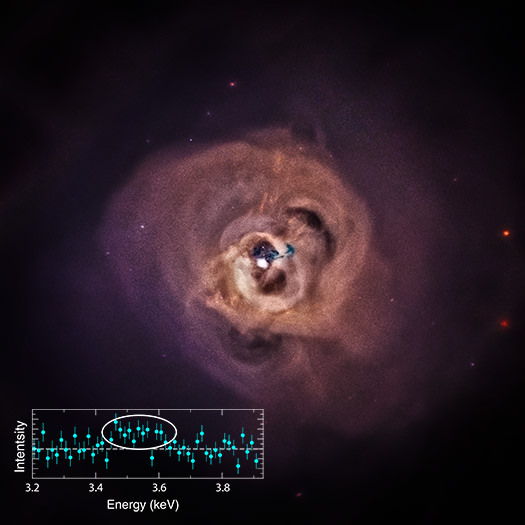SpaceShipOne is the spacecraft created by Scaled Composites to win the $10 million Ansari X-Prize in 2003. It was the first privately built spacecraft to reach 100 km in altitude, twice in two weeks, carrying the equivalent of 3 people. It’s the prototype of the upcoming SpaceShipTwo, created for Virgin Galactic to carry paying passengers into space.
Continue reading “Astronomy Cast 350: SpaceShipOne”
Beautiful Astrophotos: Crescent Moon and Venus Rising

Did you see the crescent Moon near a bright star on Tuesday morning this week? Many of our Flickr group astrophotographers captured gorgeous shots of the two together in the sky, including this eye-candy image from Alan Dyer from Canada. Just take a look!




Want to get your astrophoto featured on Universe Today? Join our Flickr group or send us your images by email (this means you’re giving us permission to post them). Please explain what’s in the picture, when you took it, the equipment you used, etc.
Three Supermassive Black Holes Tango in a Distant Galaxy, Marking a Huge Discovery
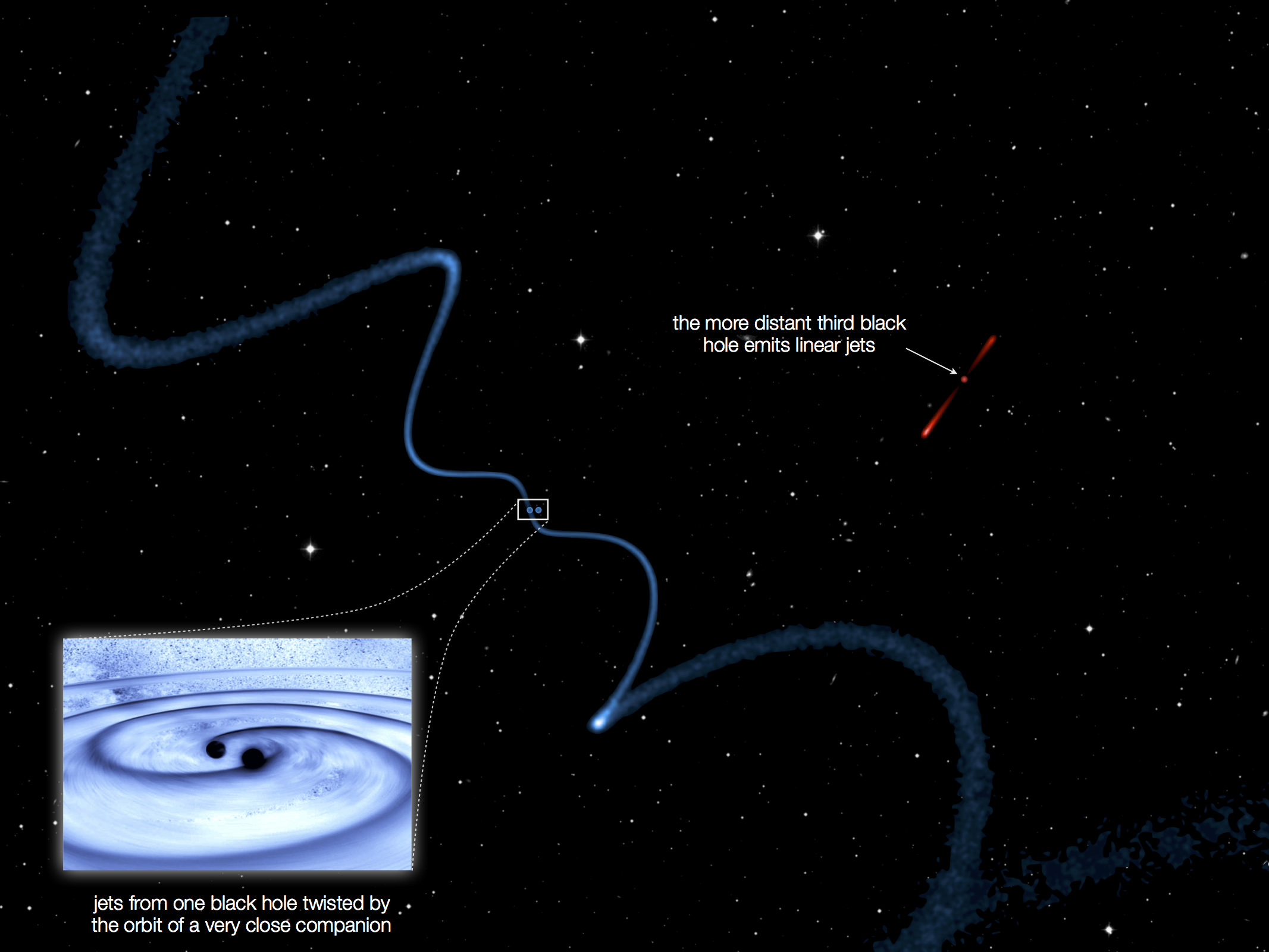
In a galaxy four billion light-years away, three supermassive black holes are locked in a whirling embrace. It’s the tightest trio of black holes known to date and even suggests that these closely packed systems are more common than previously thought.
“What remains extraordinary to me is that these black holes, which are at the very extreme of Einstein’s Theory of General Relativity, are orbiting one another at 300 times the speed of sound on Earth,” said lead author Roger Deane from the University of Cape Town in a press release.
“Not only that, but using the combined signals from radio telescopes on four continents we are able to observe this exotic system one third of the way across the Universe. It gives me great excitement as this is just scratching the surface of a long list of discoveries that will be made possible with the Square Kilometer Array.”
The system, dubbed SDSS J150243.091111557.3, was first identified as a quasar — a supermassive black hole at the center of a galaxy, which is rapidly accreting material and shining brightly — four years ago. But its spectrum was slightly wacky with its doubly ionized oxygen emission line [OIII] split into two peaks instead of one.
A favorable explanation suggested there were two active supermassive black holes hiding in the galaxy’s core.
An active galaxy typically shows single-peaked narrow emission lines, which stem from a surrounding region of ionized gas, Deane told Universe Today. The fact that this active galaxy shows double-peaked emission lines, suggests there are two surrounding regions of ionized gas and therefore two active supermassive black holes.
But one of the supermassive black holes was enshrouded in dust. So Deane and colleagues dug a little further. They used a technique called Very Long Baseline Interferometry (VLBI), which is a means of linking telescopes together, combining signals separated by up to 10,000 km to see detail 50 times greater than the Hubble Space Telescope.
Observations from the European VLBI network — an array of European, Chinese, Russian, and South American antennas — revealed that the dust-covered supermassive black hole was once again two instead of one, making the system three supermassive black holes in total.

“This is what was so surprising,” Deane told Universe Today. “Our aim was to confirm the two suspected black holes. We did not expect one of these was in fact two, which could only be revealed by the European VLBI Network due [to the] very fine detail it is able to discern.”
Deane and colleagues looked through six similar galaxies before finding their first trio. The fact that they found one so quickly suggests that they’re more common than previously thought.

Before today, only four triple black hole systems were known, with the closest pair being 2.4 kiloparsecs apart — roughly 2,000 times the distance from Earth to the nearest star, Proxima Centauri. But the closest pair in this trio is separated by only 140 parsecs — roughly 10 times that same distance.
Although Deane and colleagues relied on the phenomenal resolution of the VLBI technique in order to spatially separate the two close-in black holes, they also showed that their presence could be inferred from larger-scale features. The orbital motion of the black hole, for instance, is imprinted on its large jets, twisting them into a helical-like shape. This may provide smaller telescopes with a tool to find them with much greater efficiency.
“If the result holds up, it’ll be very cool,” binary supermassive black hole expert Jessie Runnoe from Pennsylvania State University told Universe Today. This research has multiple implications for understanding further phenomena.
The first sheds light on galaxy evolution. Two or three supermassive black holes are the smoking gun that the galaxy has merged with another. So by looking at these galaxies in detail, astronomers can understand how galaxies have evolved into their present-day shapes and sizes.
The second sheds light on a phenomenon known as gravitational radiation. Einstein’s General Theory of Relativity predicts that when one of the two or three supermassive black holes spirals inward, gravitational waves — ripples in the fabric of space-time itself — propagate out into space.
Future radio telescopes should be able to measure gravitational waves from such systems as their orbits decay.
“Further in the future, the Square Kilometer Array will allow us to find and study these systems in exquisite detail, and really allow us [to] gain a much better understanding of how black holes shape galaxies over the history of the Universe,” said coauthor Matt Jarvis from the Universities of Oxford and Western Cape.
The research was published today in the journal Nature.
Curiosity Marks Milestone Anniversary – 1 Martian Year On Mars!

NASA’s Curiosity rover celebrated a milestone anniversary today, June 24 – 1 Martian Year on Mars!
A Martian year is equivalent to 687 Earth days, or nearly two Earth years.
NASA marked the illustrious achievement with the release of a new ‘selfie’ captured recently while drilling deep into the Red Planet to unlock the secrets of Mars hidden past eons ago when the planet was far warmer and wetter and more conducive to the origin of life.
Curiosity’s new self-portrait was taken at the ‘Windjana’ Drilling Site in April and May 2014 using the Mars Hand Lens Imager (MAHLI) camera at the end of the robotic arm.
As of today the 1 ton rover has been exploring the alien surface for a full Martian year since her nail biting touchdown inside Gale Crater on Aug. 5, 2012 – using the unprecedented sky crane maneuver which culminated in a rocket assisted touchdown astride a humongous mountain named Mount Sharp.
Mount Sharp dominates the center of Gale Crater and reaches 3.4 miles (5.5 km) into the Martian sky – taller than Mount Rainier.
During Mars Year 1 on Mars, Earth’s metallic emissary has already accomplished her primary objective of discovering a habitable zone on the Red Planet that contains the chemical ingredients necessary to support microbial life in the ancient past.

During 2013, Curiosity conducted the first two drill campaigns at the ‘John Klein’ and ‘Cumberland’ outcrop targets inside Yellowknife Bay. They were both mudstone rock outcrops and the interiors were markedly different in color and much lighter compared to the new drill site at ‘Windjana’ into a slab of red, sandstone rock.
The fresh bore hole was drilled into the “Windjana” rock outcrop on May 5, 2014, Sol 621, at the base of Mount Remarkable at a science stopping point called “The Kimberley Waypoint.”
It was 0.63 inch (1.6 centimeters) in diameter and about 2.6 inches (6.5 centimeters) deep and resulted in a mound of dark grey colored drill tailings piled around.

Windjana lies some 2.5 miles (4 kilometers) southwest of Yellowknife Bay.
Curiosity has successfully delivered pulverized and sieved samples from all three drill sites to the pair of onboard miniaturized chemistry labs; the Chemistry and Mineralogy instrument (CheMin) and the Sample Analysis at Mars instrument (SAM) – for chemical and compositional analysis.

It was through the results of the SAM and CheMin analysis and the discovery of clay minerals that the science team was able to determine that this area on the floor of Gale Crater is a habitable zone.
“Windjana has more magnetite than previous samples we’ve analyzed,” said David Blake, principal investigator for Curiosity’s Chemistry and Mineralogy (CheMin) instrument at NASA’s Ames Research Center, Moffett Field, California, in a statement.
“A key question is whether this magnetite is a component of the original basalt or resulted from later processes, such as would happen in water-soaked basaltic sediments. The answer is important to our understanding of habitability and the nature of the early-Mars environment.”
Chemical analysis and further sample deliveries are in progress as NASA’s rover is ‘on the go’ to simultaneously maximize movement and research activities.

Featured on APOD – Astronomy Picture of the Day on May 7, 2014
The lower reaches of Mount Sharp are the rovers ultimate goal because the sedimentary layers are believed to hold caches of water altered minerals based on high resolution measurements obtained by the CRISM spectrometer aboard NASA’s powerful Martian ‘Spysat’ – the Mars Reconnaissance Orbiter (MRO) – soaring overhead.
Curiosity still has about another 2.4 miles (3.9 kilometers) to go to reach the entry way at a gap in the dunes at the foothills of Mount Sharp sometime later this year.

To date, Curiosity’s odometer totals over 4.9 miles (7.9 kilometers) since landing inside Gale Crater on Mars in August 2012. She has taken over 159,000 images.

Stay tuned here for Ken’s continuing Curiosity, Opportunity, Orion, SpaceX, Boeing, Orbital Sciences, commercial space, MAVEN, MOM, Mars and more planetary and human spaceflight news.
Ken Kremer
…………….
Learn more about NASA’s Mars missions, upcoming sounding rocket and Orbital Sciences Antares ISS launch from NASA Wallops, VA in July and more about SpaceX, Boeing and commercial space and more at Ken’s upcoming presentations.
June 25: “Antares/Cygnus ISS Launch (July 10) and Suborbital Rocket Launch (June 26) from Virginia” & “Space mission updates”; Rodeway Inn, Chincoteague, VA, evening
The Place Where Earth from Space Looks Like a Floating Piece of Cardboard

As we’ve noted before, astronaut Reid Wiseman is sending out a bevy of tweets and pictures from his perch on board the International Space Station, but this recent image got our attention.
“Can’t explain it, just looked oddly unnatural to me and I liked it,” Wiseman said on Twitter, leaving no info on what Earthly feature might be.
Floating cardboard? That’s what many people thought. Comments from Twitter:
Breaking news: Earth is made of Cardboard
“@astro_reid: Can’t explain it, looks oddly unnatural to me & I like it. pic.twitter.com/OEzZpH85FZ”
— Connor P (@connorpj1) June 23, 2014
@astro_reid it's a piece of cardboard with some sugar icing spilt on it…no???!!!! 😉
— Anna Richards (@mrsannarichards) June 23, 2014
@astro_reid @NASA Looks like a piece of floating cardboard. Do you know where it was Reid? Thanks
— Stephane Gentile (@FrenchScotPilot) June 23, 2014
So what is this image and where on Earth is it?
I checked with Peter Caltner, who regularly tweets information on astronaut photos and he said the image shows Western Sahara, near El Aaiun (coordinates 26.824071,-13.222504) and the straight white line is a conveyor belt facility from a phosphate mine at Bou Craa that goes to a loading port at the coast. The conveyer belt is about 60 miles/100 km long, Peter noted.
You can see more images of this feature in this Google search, but none of them have quite the angle Wiseman had, which gave it the straight-edge box-like appearance from space.
See more comments about the image here.
Thanks again to Peter Caltner for his assistance!
Titan’s Atmosphere May be Older than Saturn, a New Study Suggests

It’s well accepted that moons form after planets. In fact, only a few months ago, astronomers spotted a new moon forming deep within Saturn’s rings, 4.5 billion years after the planet initially formed.
But new research suggests Saturn’s icy moon Titan — famous for its rivers and lakes of liquid methane — may have formed before its parent planet, contradicting the theory that Titan formed within the warm disk surrounding an infant Saturn.
A combined NASA and ESA-funded study has found firm evidence that the nitrogen in Titan’s atmosphere originated in conditions similar to the cold birthplace of the most ancient comets from the Oort cloud — a spherical shell of icy particles that enshrouds the Solar System.
The hint comes in the form of a ratio. All elements have a certain number of known isotopes — variants of that element with the same number of protons that differ in their number of neutrons. The ratio of one isotope to another isotope is a crucial diagnostic tool.
In planetary atmospheres and surface materials, the amount of one isotope relative to another isotope is closely tied to the conditions under which materials form. Any change in the ratio will allow scientists to deduce an age for that material.
Kathleen Mandt from the Southwest Research Institute in San Antonio and colleagues analyzed the ratio of nitrogen-14 (seven protons and seven neutrons) to nitrogen-15 (seven protons and eight neutrons) in Titan’s atmosphere.
“When we looked closely at how this ratio could evolve with time, we found that it was impossible for it to change significantly,” Mandt said in a press release. “Titan’s atmosphere contains so much nitrogen that no process can significantly modify this tracer even given more than four billion years of Solar System history.”
The team found that our Solar System is not old enough for this nitrogen isotope ratio to have changed as much as it has. By comparing the small change within this ratio, Mandt and colleagues found that it seemed more similar to Oort cloud comets than to Solar System bodies including planets and comets born in the Kuiper belt. The team is eager to see whether their findings are supported by data from ESA’s Rosetta mission, which will study comet 67P/Churyumov-Gerasimenko later this year.
Finally, the study also has implications for Earth. In the past, researchers assumed a connection between comets, Titan and Earth. But these results show that the nitrogen isotope ratio is different on Titan and Earth, suggesting the sources of Earth’s and Titan’s nitrogen must have been different.
It’s unclear whether Earth received nitrogen from early meteorites or if it was captured directly from the disk of gas that formed the Solar System.
“This exciting result is a key example of Cassini science informing our knowledge of the history of [the] Solar System and how Earth formed,” said Scott Edgington, Cassini deputy project scientist at NASA’s Jet Propulsion Laboratory.
The research was published this week in the Astrophysical Journal Letters.
Intriguing X-Ray Signal Might be Dark Matter Candidate
Could a strange X-ray signal coming from the Perseus galaxy cluster be a hint of the elusive dark matter in our Universe?
Using archival data from the Chandra X-ray Observatory and the XMM-Newton mission, astronomers found an unidentified X-ray emission line, or a spike of intensity at a very specific wavelength of X-ray light. This spike was also found in 73 other galaxy clusters in XMM-Newton data.
The scientists propose that one intriguing possibility is that the X-rays are produced by the decay of sterile neutrinos, a hypothetical type of neutrino that has been proposed as a candidate for dark matter and is predicted to interact with normal matter only via gravity.
“We know that the dark matter explanation is a long shot, but the pay-off would be huge if we’re right,” said Esra Bulbul of the Harvard-Smithsonian Center for Astrophysics (CfA) in Cambridge, Massachusetts, who led the study. “So we’re going to keep testing this interpretation and see where it takes us.”
Astronomers estimate that roughly 85 percent of all matter in the Universe is dark matter, invisible to even the most powerful telescopes, but detectable by its gravitational pull.
Galaxy clusters are good places to look for dark matter. They contain hundreds of galaxies as well as a huge amount of hot gas filling the space between them. But measurements of the gravitational influence of galaxy clusters show that the galaxies and gas make up only about one-fifth of the total mass. The rest is thought to be dark matter.
Bulbul explained in a post on the Chandra blog that she wanted try hunting for dark matter by “stacking” (layering observations on top of each other) large numbers of observations of galaxy clusters to improve the sensitivity of the data coming from Chandra and XMM-Newton.
“The great advantage of stacking observations is not only an increased signal-to-noise ratio (that is, the amount of useful signal compared to background noise), but also the diminished effects of detector and background features,” wrote Bulbul. “The X-ray background emission and instrumental noise are the main obstacles in the analysis of faint objects, such as galaxy clusters.”
Her primary goal in using the stacking technique was to refine previous upper limits on the properties of dark matter particles and perhaps even find a weak emission line from previously undetected metals.
“These weak emission lines from metals originate from the known atomic transitions taking place in the hot atmospheres of galaxy clusters,” said Bulbul. “After spending a year reducing, carefully examining, and stacking the XMM-Newton X-ray observations of 73 galaxy clusters, I noticed an unexpected emission line at about 3.56 kiloelectron volts (keV), a specific energy in the X-ray range.”
In theory, a sterile neutrino decays into an active neutrino by emitting an X-ray photon in the keV range, which can be detectable through X-ray spectroscopy. Bulbul said that her team’s results are consistent with the theoretical expectations and the upper limits placed by previous X-ray searches.
Bulbul and her colleagues worked for a year to confirm the existence of the line in different subsamples, but they say they still have much work to do to confirm that they’ve actually detected sterile neutrinos.
“Our next step is to combine data from Chandra and JAXA’s Suzaku mission for a large number of galaxy clusters to see if we find the same X-ray signal,” said co-author Adam Foster, also of CfA. “There are lots of ideas out there about what these data could represent. We may not know for certain until Astro-H launches, with a new type of X-ray detector that will be able to measure the line with more precision than currently possible.”
Astro-H is another Japanese mission scheduled to launch in 2015 with a high-resolution instrument that should be able to see better detail in the spectra, and Bulbul said they hope to be able to “unambiguously distinguish an astrophysical line from a dark matter signal and tell us what this new X-ray emission truly is.”
Since the emission line is weak, this detection is pushing the capabilities Chandra and XMM Newton in terms of sensitivity. Also, the team says there may be explanations other than sterile neutrinos if this X-ray emission line is deemed to be real. There are ways that normal matter in the cluster could have produced the line, although the team’s analysis suggested that all of these would involve unlikely changes to our understanding of physical conditions in the galaxy cluster or the details of the atomic physics of extremely hot gases.
The authors also note that even if the sterile neutrino interpretation is correct, their detection does not necessarily imply that all of dark matter is composed of these particles.
The Chandra press release shared an interesting behind-the-scenes look into how science is shared and discussed among scientists:
Because of the tantalizing potential of these results, after submitting to The Astrophysical Journal the authors posted a copy of the paper to a publicly accessible database, arXiv. This forum allows scientists to examine a paper prior to its acceptance into a peer-reviewed journal. The paper ignited a flurry of activity, with 55 new papers having already cited this work, mostly involving theories discussing the emission line as possible evidence for dark matter. Some of the papers explore the sterile neutrino interpretation, but others suggest different types of candidate dark matter particles, such as the axion, may have been detected.
Only a week after Bulbul et al. placed their paper on the arXiv, a different group, led by Alexey Boyarsky of Leiden University in the Netherlands, placed a paper on the arXiv reporting evidence for an emission line at the same energy in XMM-Newton observations of the galaxy M31 and the outskirts of the Perseus cluster. This strengthens the evidence that the emission line is real and not an instrumental artifact.
Further reading:
Paper by Bulbul et al.
Chandra press release
ESA press release
Chandra blog
Observing Alert: Distant Blazar 3C 454.3 in Outburst, Visible in Amateur Telescopes
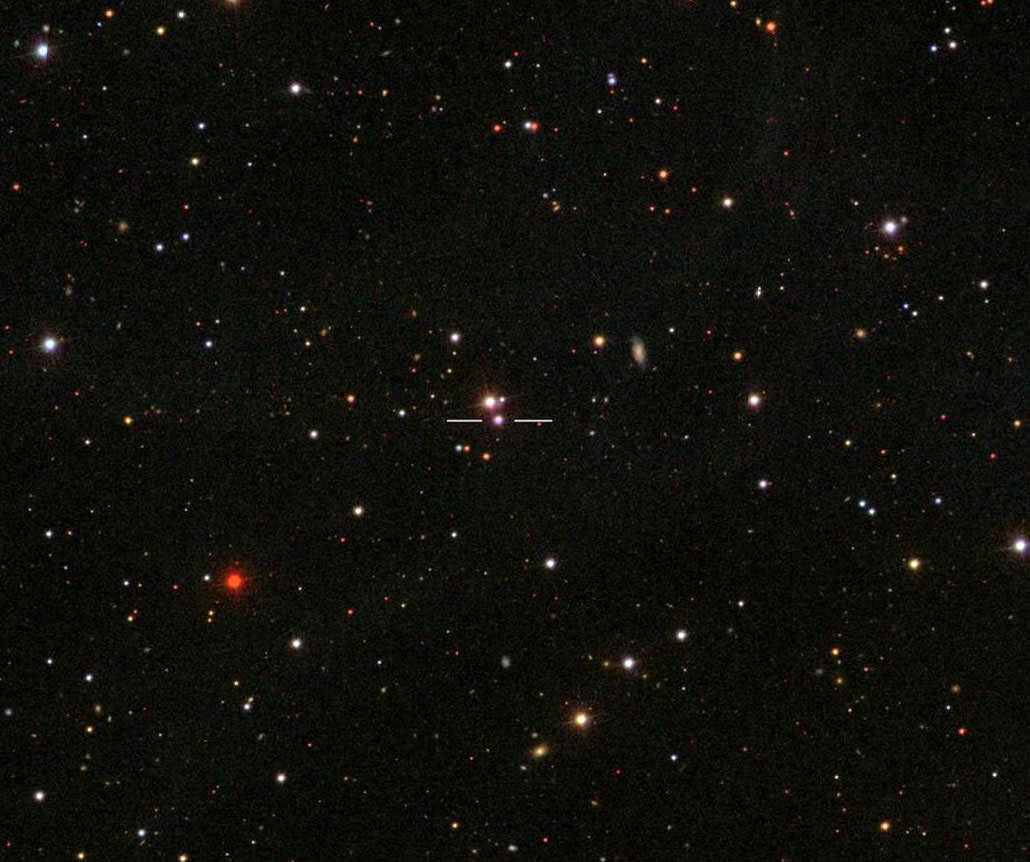
Have an 8-inch or larger telescope? Don’t mind staying up late? Excellent. Here’s a chance to stare deeper into the known fabric of the universe than perhaps you’ve ever done before. The violent blazer 3C 454.3 is throwing a fit again, undergoing its most intense outburst seen since 2010. Normally it sleeps away the months around 17th magnitude but every few years, it can brighten up to 5 magnitudes and show in amateur telescopes. While magnitude +13 doesn’t sound impressive at first blush, consider that 3C 454.3 lies 7 billion light years from Earth. When light left the quasar, the sun and planets wouldn’t have skin in the game for another two billion years.
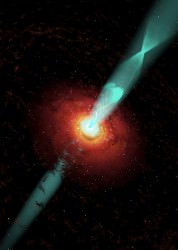
Blazars form in the the cores of active galaxies where supermassive black holes reside. Matter falling into the black hole spreads into a spinning accretion disk before spiraling down the hole like water down a bathtub drain.
Superheated to millions of degrees by gravitational compression the disk glows brilliantly across the electromagnetic spectrum. Powerful spun-up magnetic fields focus twin beams of light and energetic particles called jets that blast into space perpendicular to the disk.
Blazars and quasars are thought to be one and the same, differing only by the angle at which we see them. Quasars – far more common – are actively- munching supermassive black holes seen from the side, while in blazars – far more rare – we stare directly or nearly so into the jet like looking into the beam of a flashlight.
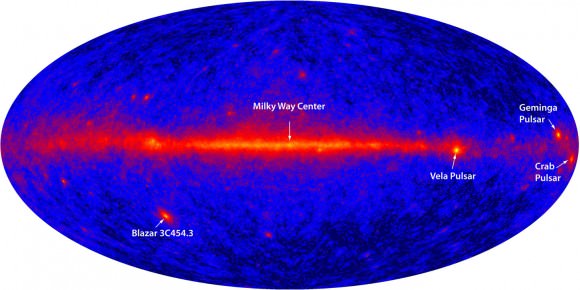
3C 454.3 is one of the top ten brightest gamma ray sources in the sky seen by the Fermi Gamma-ray Space Telescope. During its last major flare in 2005, the blazar blazed with the light of 550 billion suns. That’s more stars than the entire Milky Way galaxy! It’s still not known exactly what sets off these periodic outbursts but possible causes include radiation bursts from shocked particles within the jet or precession (twisting) of the jet bringing it close to our line of sight.

The current outburst began in late May when the Italian Space Agency’s AGILE satellite detected an increase in gamma rays from the blazar. Now it’s bright visually at around magnitude +13.6 and fortunately not difficult to find, located in the constellation Pegasus near the bright star Alpha Pegasi (Markab) in the lower right corner of the Great Square asterism.
Using the wide view map, find your way to IM Peg via Markab and then make a copy of the detailed map below to use at the telescope to star hop to 3C 454.3. The blazar lies immediately south of a star of similar magnitude. If you see what looks like a ‘double star’ at the location, you’ve nailed it. Incredible isn’t it to look so far into space back to when the universe was just a teenager? Blows my mind every time.
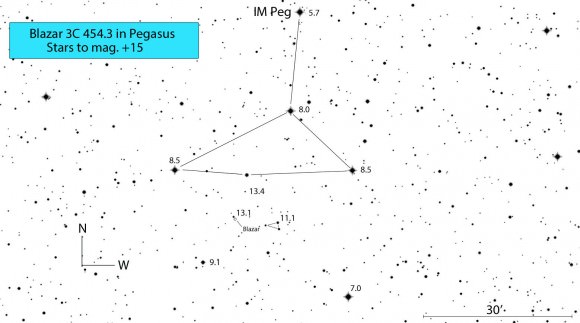
To further explore 3C 454.3 and blazars vs. quasars I encourage you to visit check out Stefan Karge’s excellent Frankfurt Quasar Monitoring site. It’s packed with great information and maps for finding the best and brightest of this rarified group of observing targets. Karge suggests that flickering of the blazar may cause it to appear somewhat brighter or fainter than the current magnitude. You’re watching a violent event subject to rapid and erratic changes. For an in-depth study of 3C 454.3, check out the scientific paper that appeared in the 2010 Astrophysical Journal.
Learn more about quasars and blazers with a bit of great humor
Finally, I came across a wonderful video while doing research for this article I thought you’d enjoy as well.
‘Ghost’ Object Appears, Disappears on Titan

Astronomers with the Cassini mission have detected a bright, mysterious geologic object on Saturn’s moon Titan that suddenly showed up in images from the mission’s radar instrument. The object appeared in Ligeia Mare, the second-largest sea Titan. The feature looks like an island and so the team named it “Magic Island.” However, it most likely is not an island that suddenly surfaced. But scientists say this may be the first observation of dynamic, geological processes in Titan’s northern hemisphere.
The object suddenly showed up in images beamed back from Cassini on July 10, 2013, showing regions of Ligeia Mare, a sea located near Titan’s north pole. But then just as suddenly, in a follow-up flyby only days later on July 26, the island was gone. Subsequent flybys confirmed that Magic Island had vanished and is what is known as a “transient feature.”
“This discovery tells us that the liquids in Titan’s northern hemisphere are not simply stagnant and unchanging, but rather that changes do occur,” said Jason Hofgartner, a Cornell graduate student in the and the lead author of a paper appearing in Nature Geoscience. “We don’t know precisely what caused this ‘magic island’ to appear, but we’d like to study it further.”

Titan is currently the only other world besides Earth known to have stable bodies of liquid on its surface. But unlike Earth, Titan’s lakes aren’t filled with water — instead they’re full of liquid methane and ethane, organic compounds which are gases on Earth but liquids in Titan’s incredibly chilly -290º F (-180º C) environment.
So what was this object? Among the explanations from the team are:
- Northern hemisphere winds may be kicking up and forming waves on Ligeia Mare. The radar imaging system might see the waves as a kind of “ghost” island. Scientists previously have seen what they think are waves in another nearby Titan sea, Punga Mare.
- Gases may push out from the sea floor of Ligeia Mare, rising to the surface as bubbles.
- Sunken solids formed by a wintry freeze could become buoyant with the onset of the late Titan spring warmer temperatures.
- Suspended solids in Ligeia Mare, which are neither sunken nor floating, but act like silt in a terrestrial delta.
“Likely, several different processes – such as wind, rain and tides – might affect the methane and ethane lakes on Titan. We want to see the similarities and differences from geological processes that occur here on Earth,” Hofgartner said. “Ultimately, it will help us to understand better our own liquid environments here on the Earth.”
Source: Cornell University
An Earth-size Diamond in the Sky: The Coolest Known White Dwarf Detected
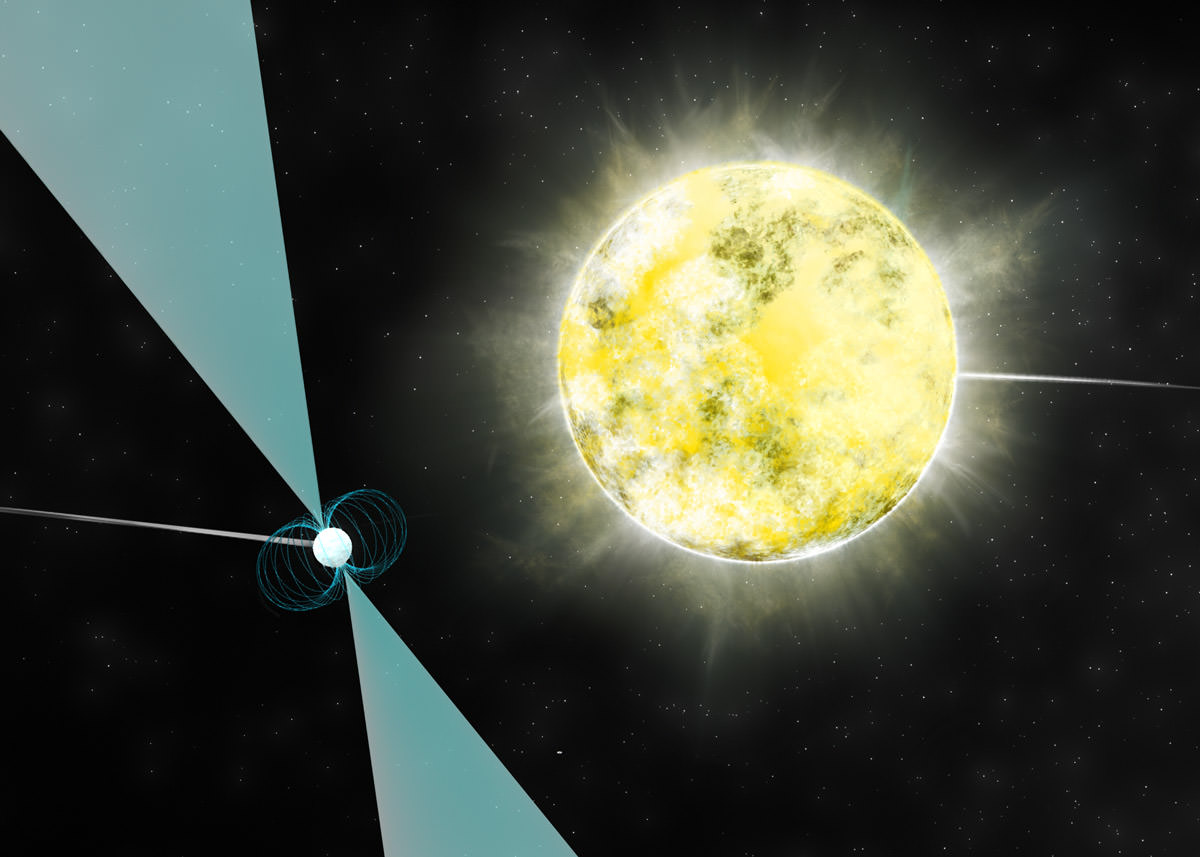
We live in a vast, dark Universe, which makes the smallest and coolest objects extremely difficult to detect, save for a stroke of luck. Often times this luck comes in the form of a companion. Take, for example, the first exoplanet detected due to its orbit around a pulsar — a rapidly spinning neutron star.
A team of researchers using the National Radio Astronomy Observatory’s Green Bank Telescope and the Very Long Baseline Array (VLBA), as well as other observatories have repeated the story, detecting an object in orbit around a distant pulsar. Except this time it’s the coldest, faintest white dwarf ever detected. So cool, in fact, its carbon has crystallized.
The punch line is this: with the help of a pulsar, astronomers have detected an Earth-size diamond in the sky.
“It’s a really remarkable object,” said lead author David Kaplan from the University of Wisconsin-Milwaukee in a press release. “These things should be out there, but because they are so dim they are very hard to find.”
The story begins when Dr. Jason Boyles, then a graduate student at West Virginia University, identified a pulsar, dubbed PSR J2222-0127, 900 light-years away in the constellation Aquarius.
When the core of a massive star runs out of energy, it collapses to form an incredibly dense neutron star or black hole. Bring a teaspoon of neutron star to Earth and it would outweigh Mount Everest at about a billion tons. A pulsar is simply a spinning neutron star.
But as a pulsar spins, lighthouse-like beams of radio waves stream from the poles of its powerful magnetic field. If they sweep past the Earth, they’ll give rise to blips of radio waves, so regular that you could set your watch by them. But if the pulsar carries a companion in tow, the tiny gravitational tugs can offset that timing slightly.
The first observations of PSR J2222-0137 identified that it was spinning more than 30 times each second. It was then observed over a two-year period with the VLBA. By applying Einstein’s theory of relativity — which predicts that light slows in the presence of a gravitational field — the researchers studied how the gravity of the companion warped space, causing delays in the radio signal as the pulsar passed behind it.
The delayed travel times helped the researchers determine the individual masses of the two stars. The pulsar has a mass of 1.2 times that of the Sun and the companion a mass 1.05 times that of the Sun. Previously, researchers had thought the companion was likely another neutron star, or a white dwarf, the remnant of a Sun-like star.
But the timing variations made the neutron star scenario unlikely. The orbits were too orderly for a second supernova to have taken place. So knowing the typical brightness of a white dwarf and its distance, astronomers initially thought they would be able to detect the elusive companion in optical and infrared light.
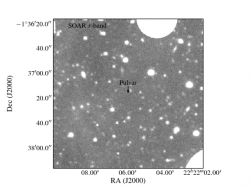
However, neither the Southern Astrophysical Research telescope in Chile nor the 10-meter Keck telescope in Hawaii was able to detect it.
“Our final image should show us a companion 100 times fainter than any other white dwarf orbiting a neutron star and about 10 times fainter than any known white dwarf, but we don’t see a thing,” said coauthor Bart Dunlap, a graduate student at the University of North Carolina. “If there’s a white dwarf there, and there almost certainly is, it must be extremely cold.”
The research team calculated that the white dwarf would be no more than 3,000 degrees Kelvin. At such a low temperature, the collapsed star would be largely crystallized carbon, similar to diamond.
The paper has been accepted for publication in the Astrophysical Journal and may be viewed here.

